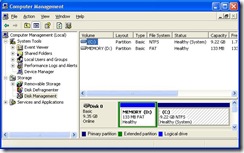A reader e-mailed me a question I believe will be of interest to other readers of this series. He wants to use a thumb drive to transfer files between his computer at his work and his home computer, but the work computer will not recognize the thumb drive. He wanted advice on how to fix this.
Q: My thumb drive works great at home, but when I took it into work to try and copy some files so I could work at home, I plug it in and the little window never opens so I cannot use it. What am I doing wrong?
A: There are several possible reasons for this, and here's a few things to try:
* One may be that Windows is "recognizing" the device, but isn't displaying the little "Found new hardware" balloon for some reason (such as a Service isn't running). Open My Computer, Start >My Computer, (just "Computer" in Vista) and look for the drive there. If it's there, great, just double-click it, but if it's not...
* Try plugging the drive into a different USB port. It is possible that the one you tried has "gone bad". If that isn't it...
* Ask your company's IT department if USB volumes have been disabled. Many companies are turning off USB access to iPods/Media Players and thumb drives (storage devices) in an effort to prevent "data leakage".. which is a fancy way of saying, preventing the employees from walking out the door with the Company Secrets. If this is indeed the case, you can ask that an exception be made in your case. If your request is granted, they will re-"enable" USB storage devices on your machine.
But if that isn't it...
* It is possible that the drive letter your thumb drive is pre-disposed to being assigned (say, "E:" or "F:"), is being used by another device or "share" on the company network, and so it isn't being seen as a volume (aka "drive").. you'll have a volume, but without a drive letter, Windows won't "see" it and you can't use it.
a) Right-click on My Computer and select "Manage" from the context menu.
b) click the "+" sign next to "Storage" to expand the tree, and then click on "Disk Management".
You will now see all the volumes on your computer..
This screenshot shows that I have two volumes/drives, and that they both have been assigned drive letters [(C:) and (D:)] -- this means they're "recognized" and fully functional. What we're looking for in our thumb drive issue is a volume that does not have a letter.
c) If you see one (that will be the troublesome thumb drive), right-click on it and select "Change Drive Letter and Paths..." from the context menu. A small window will open.
d) click on the "Add" button, and another small window will open. Use the drop-down arrow next to "Assign the following drive letter" and choose one of the letters (those shown will be "available" letters on the company network). It really doesn't matter which letter you choose. Then click "OK", and "OK" again.
You should now be back in business, and you can use the thumb drive as you're used to. Open My Computer again and you'll see the thumb drive and double-clicking it will open it up.
* If these steps fail to allow Windows to see the USB thumb drive, submit a trouble ticket to your company's IT department.
Today's free link: Once upon a time, the visionaries of IT thought that the answer to creating a "paperless society", and getting all the disparate machine types talking to each other, was the PDF (portable document format). The PDF was to be create-able by anyone and readable by anyone, but Adobe didn't see much profit in that... If you find that you need to create a PDF, but don't have Acrobat or Word 2007, you can do so by downloading PrimoPDF, which can convert over 300 formats into .pdf's.
Copyright 2007-8 © Tech Paul. All rights reserved.
| Share this post : |

No comments:
Post a Comment